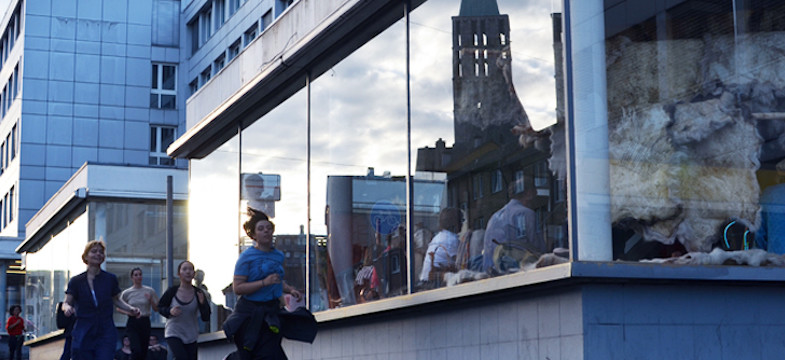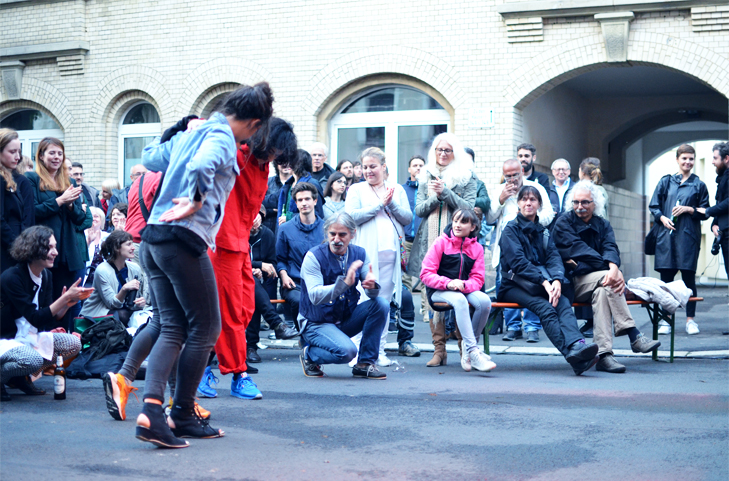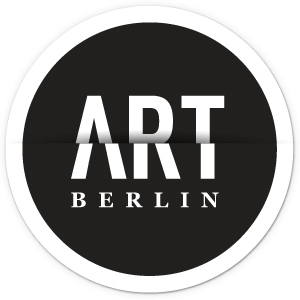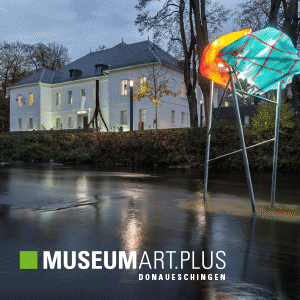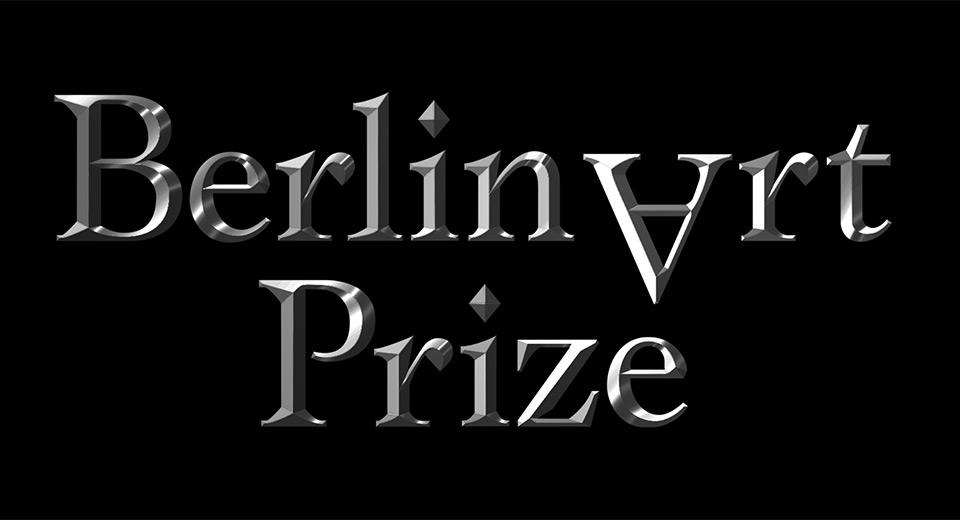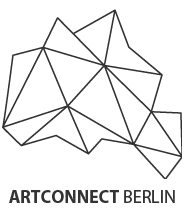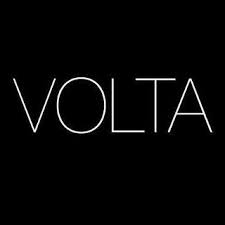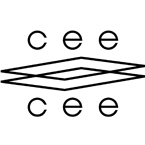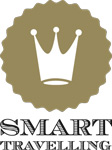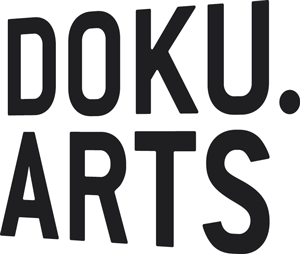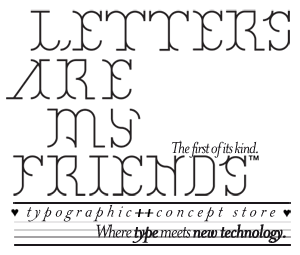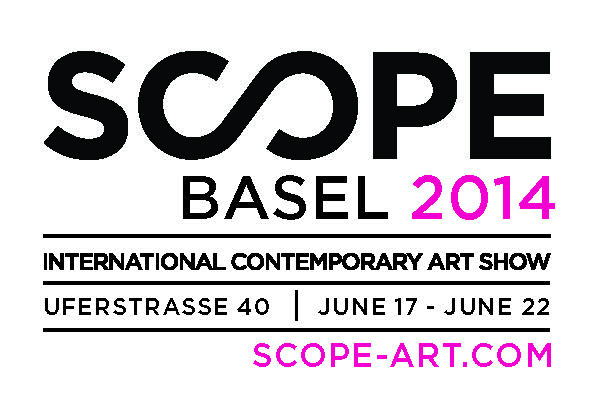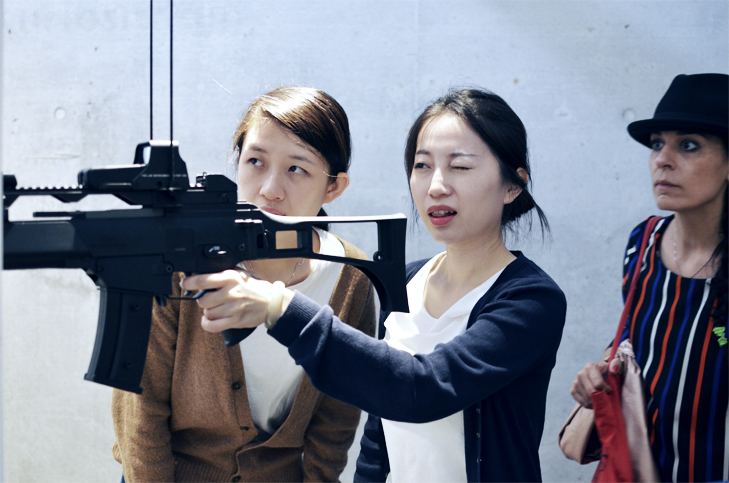
Asian women taking part in Regina José Galindo’s performance ‚El Objectivo’ at Stadtmuseum Kassel, which provides an on purpose-built chamber with four G36 assault-ruffles; the visitor only can see Galindo by looking down the barrel oft he guns.
The artistic director and conceptual tailor of d14, Adam Szymczyk, knows his concept of showing concurrently in Athens goes well beyond the comfort zone: Kassel fears a loss of importance, and political and cultural activists in both Greece and Germany drop volatile phrases into the discussion; “cultural colonialism“‚ “cultural imperialism“‚ “crisis-tourism“.
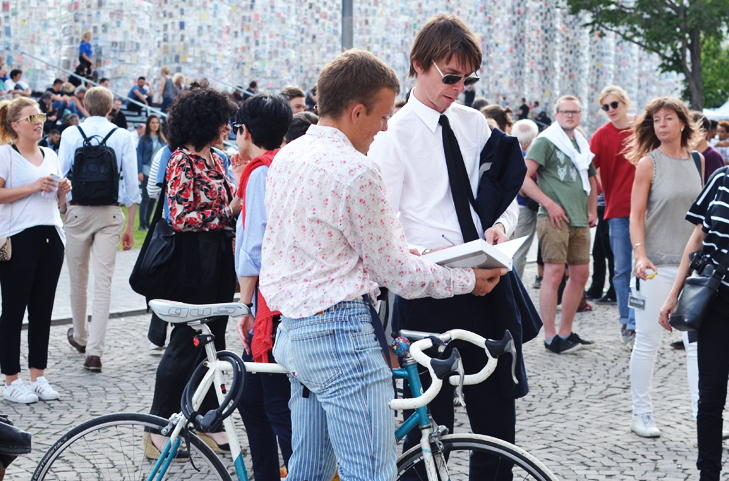
Documenta’s artistic director Adam Szcymczyk signing the main book of documenta14 -‚The Reader’; which provides essays, allegories, poems, historical legal documents and hibrid literary others.
Accordingly, the art crowd’s excitement is stoked, and expectations are raised tremendously for the impact of this quinquennale’s event. What will the show’s stated theme „Learning from Athens“ reveal, not just about the host cities, but about the nature of the show itself?
After Athens’ rousing success with 339,000 visitors, all eyes turn to Kassel. And for ARTBerlin, the goal is to combine a picture of the experiences at both sites to get a holistic sense of the d14 concept.
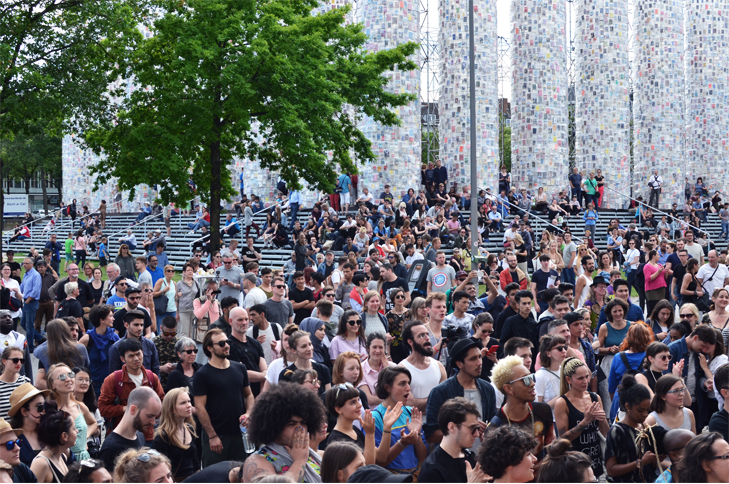
Crowd in front of Fridericianum, listening to the show of ‚Negros tou Moria’ who’s Greek rap-lyrics just got into focus after being translated: Discovery of women desprizing ideas coming with the flowing rhymes.
In Kassel, the first artist we speak with is the Dean of ASFA (Athens School of Fine Arts) – Panos Charalambous. He is participating in Kassel with his sound performance, Voice-o-graph. “I do like the concept of documenta coming to Athens,“ he says,
Greece is like a weak organ of Europe, with d14 people are taking care to help cure the sickness.
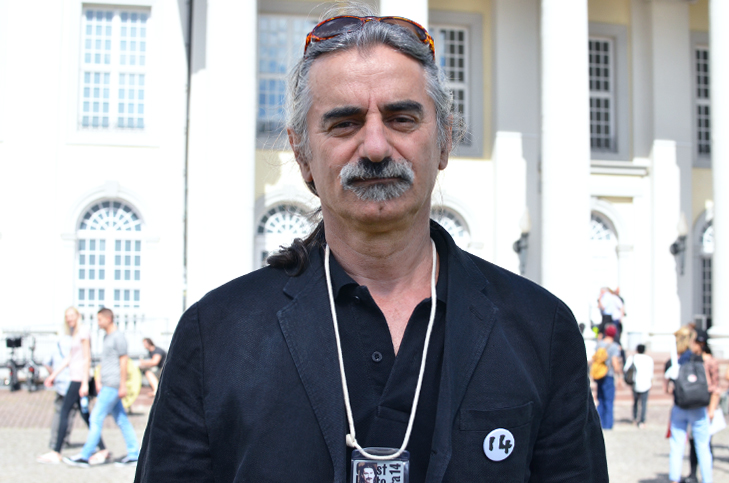
Panos Charalambous is participating with his art in Athens and Kassel. Beyond performing as documenta14 artist, Charalambous holds the position ‚Dean of the ASFA’ (Athens School of Fine Arts).
Charalambous holds an important role as an ambassador for Greece, prominently visible as he stands next to Sczymczyk during d14’s “unofficial opening“ (Sczymczyk) at the traditional 39th International Spring Festival at the Cultural Center Schlachthof, situated in the underprivileged district of Kassel Nordstadt. Panos Charalambous and the musicians of Anonimi add an engaging Greek flavor, documenta14-Athens-team-members celebrate with traditional Greek dances and then make room for a spontaneous performance from choreographer and documenta artist Alexandra Bachzetsis as she poignantly turns the asphalt into a stage. While the spellbound crowd forms a natural arena, the professional artist merges with the art of the moment. We experience, in the usually neglected urban district of Kassel, that Art that is happening can release unutterable energies, as people become actively involved with their own presence.
Alongside performances, public programs including talks and workshops formed a strong part of documenta14 in Athens. What about in Kassel? Inauguration week offers plenty of performances. Are the ones we attend in Kassel different from those in Athens? Or does the scenery and history of Kassel engender a ’white cube’ atmosphere, and stifle experimentation?
In Kassel we feel free to purely inhale the art – but something appears to be missing.
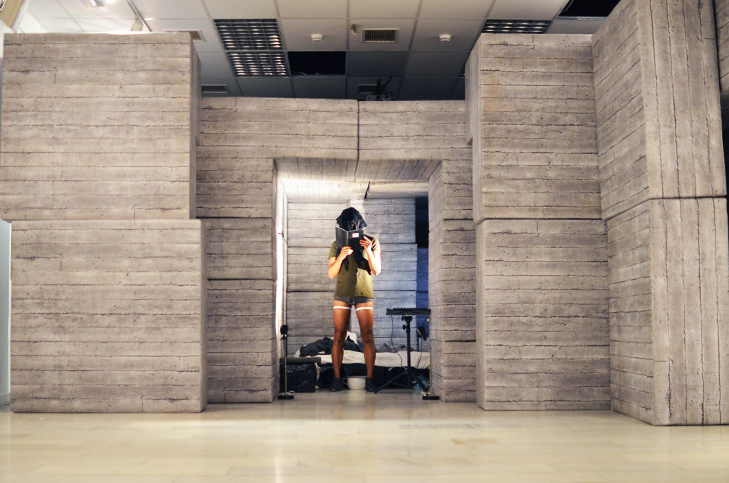
Sergio Zevallos at the ‚Never Closing’ event of documenta14 in Athens, contributing the final performance of the Parliament of Bodies at Parko Eleftherias in Athens: ‚Conversation with a dying soldier’. Zevallos asks: „How far is love from a political practice?“
Someone who did not attend d14 in Athens certainly doesn’t have the chance to learn from the sister city simply by venue-hopping in Kassel. If you missed out on Athens, there is one artwork that keeps the Learning from the city of Athens feeling alive in Kassel – BEING SAFE IS SCARY, the inscription at Fridericianum (artist Banu Cennetoglu) enthroned above Friedrichsplatz, facing Marta Minujin’s Parthenon of Books, consisting of a voluminous construction made from prohibited books.
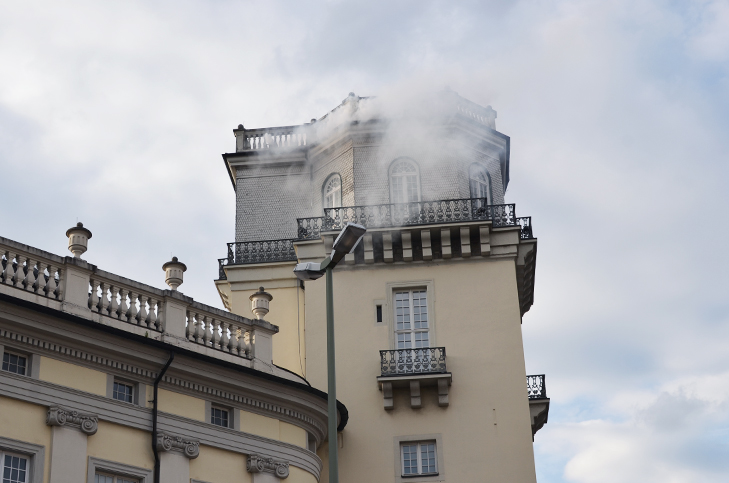
‚Expiration Movement’ by Daniel Knorr is a symbol for the running documenta14 exhibition in Athens; after the closing in Athens there is still white smoke appearing on the top of Zwehrenturm. – Like a factory that keeps producing after the product sells on the (art) market!?
Coming from Athens where the crisis is visible in the everyday, this engraving hits hard. Being safe really is scary. documenta in Kassel feels like “business as usual“. The 200,000 population city is clean, people are fed, well dressed; no scent of a national weak-point when walking the streets, when renting an airbnb, and finding yourself staying in a family’s home (where does the family find itself?), no story of 3,000 refugees living only around Victoria Square, where Rick Lowe now has an open studio as a d14-community project. When interviewing a woman in Athens about documenta, she declares
“I do like the concept that the art show comes to Athens and puts us in focus, but I clearly cannot enjoy documenta, it’s just not the time for the art. I lost the battle, I will lose my apartment. We have other problems here, we are not ready for art. It’s not the time, at all.“
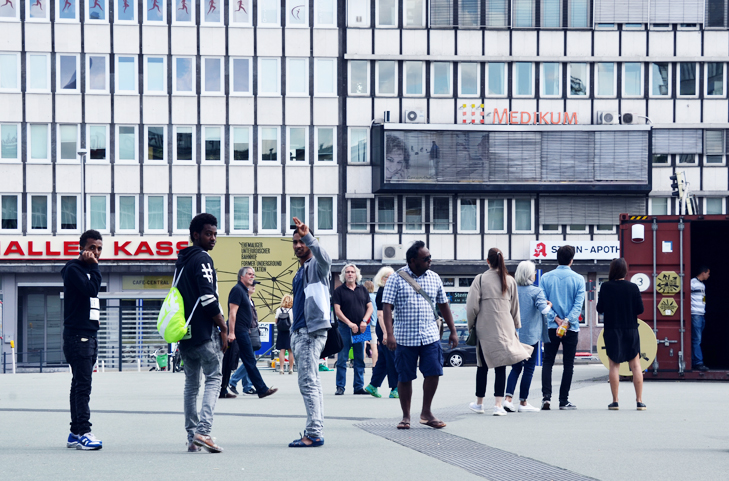
We (all) are the people’ (Hans Haacke for documenta14). And we are all strangers – Kassel takes us in; referring to the engraving of the Obelisk ‚I was a stranger and you took me in’ – Matthew 25.35 – by Olu Oguibe.
Kassel, on the other hand, is ready for the art. Being safe comes with great advantages.
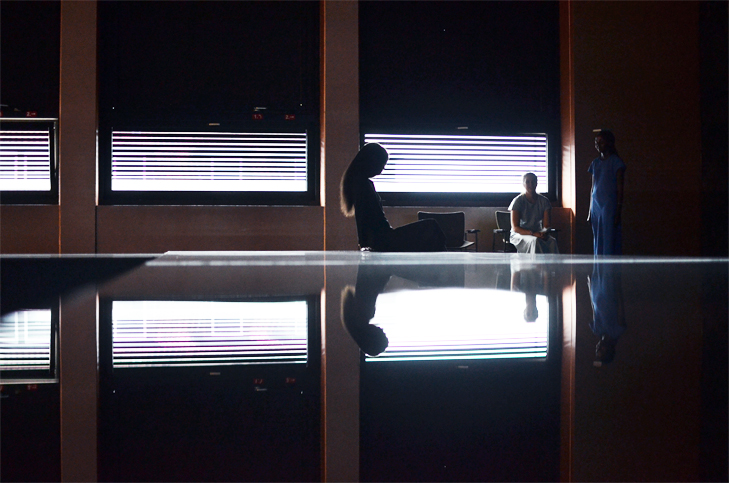
The Showroom for the Yugoexport collection for documenta14 by Irena Haiduk at Neue Neue Galerie includes a shiny catwalk; a mannequin is permanently seated in one corner, seemingly to interact with the Sirens of Haiduk’s performance work ‚Spinal Discipline’: An army of beautiful women balancing Marcel Proust’s Volume 12/of13 of the authors collected works published in Yugoslavia in 1967.
It seems the most useful advice for visiting documenta14 is that taking the time to familiarise oneself with an art-piece can make a world of difference. The documenta daybook and website provide important background information vital to the understanding of each artist and their documenta14 artwork. There are works that are immediately graspable, such as Guillermo Galindo’s concert Sonic Borders on instruments built with the debris of refugee boats: The sounds offer an intuitive perception, instill a visceral feeling of suffering, a deep inner concussion – tortured with sounds and the undeniable awareness of context.
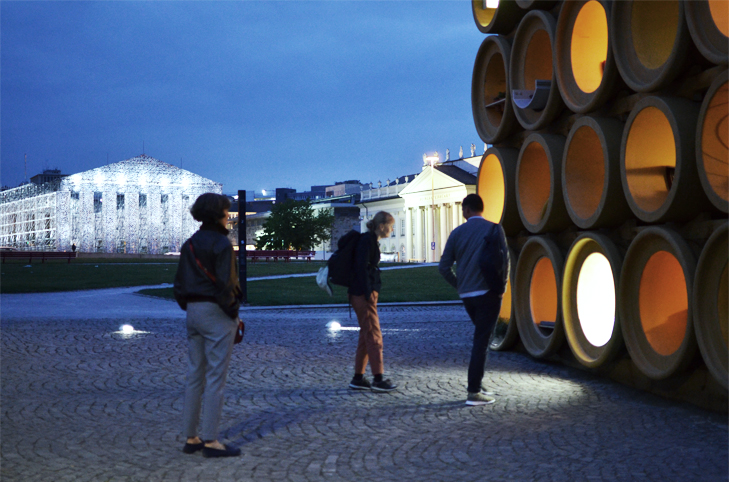
Evening atmosphere at the documenta14 area: Marta Minujin’s enlighted ‚Parthenon of books’; Fridericianum and Hiwa K.’s tubes ‚When We Were Exhaling Images’.
Other pieces demand an audience open and willing to propel themself into the depths. Consider, for instance, Hiwa K.’s giant tubes turned into homes. The sculpture is placed in front of Documenta Halle, and the act of equipping the tubes as homes with the help of design students plays on the IKEA-mentality of small space apartments. So far so cute, but the contrast comes with the flavor of reality – the Iraqi artist once fled his country hiding in a tube. We heard about this way of escaping in the media – without the IKEA angle. The installation narrows in on complicated times with unsolvable problems.
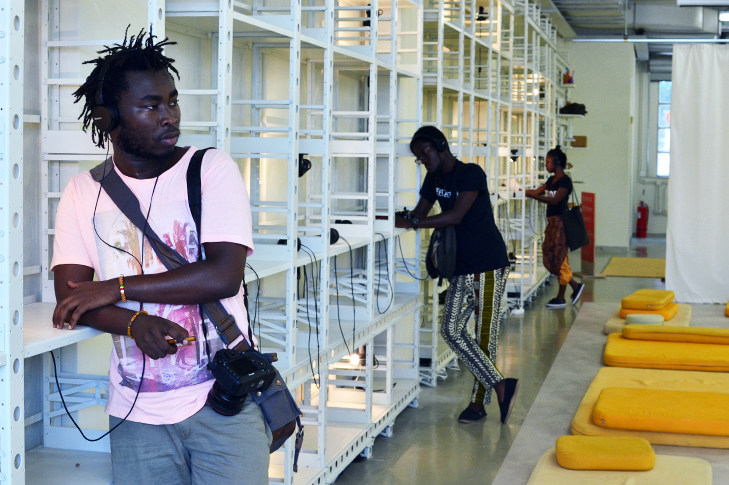
Jaques ‚Jack‘ Nkinzingabo and his fellow travellers listening to various sounds at the old library of the Athens School of Fine Arts. Jack is a young photographer from Rwanda visiting documenta14 in Kassel and Athens with a group of actors of the African art scene on a program run by Goethe-Institut.
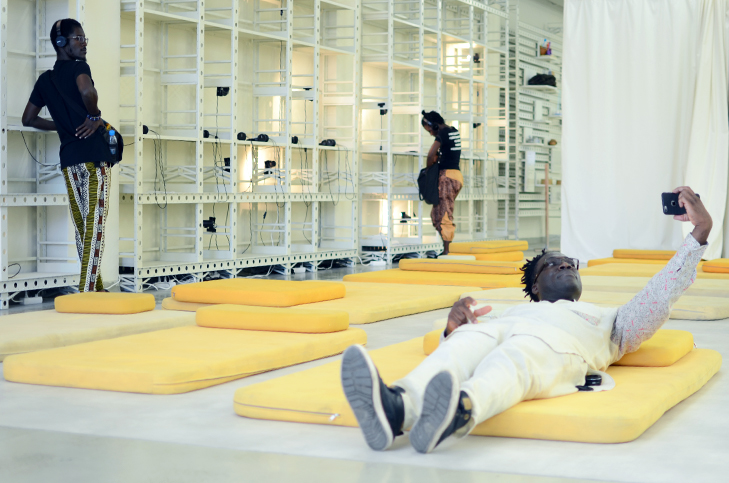
documenta14 Selfie: Jacob Bleu, artist from Ivory Coast makes a photograph before relaxing on a cosy mattress at the Athens School of Fine Arts. – In 2017 Jacob Bleu held the first International Meeting of Digital Arts in Africa at the French Institute of Ivory Coast supported by UNESCO digital city; Jacob Bleu studied documenta14 in Kassel and Athens by invitation of Goethe-Institut.
To approach documenta is challenging work, and the first step towards a satisfactory engagement is to move out of the cozy lethargy brought about by information overload and attempt to open doorways to layers of understanding, unfamiliar perspectives and deeper appreciation. Since the opening week in Athens, we were left asking what this “Learning from Athens“ was all about, and as Athens offered numerous angles of potential learning, how does the documenta crowd Learn from Athens when attending the show in Kassel?
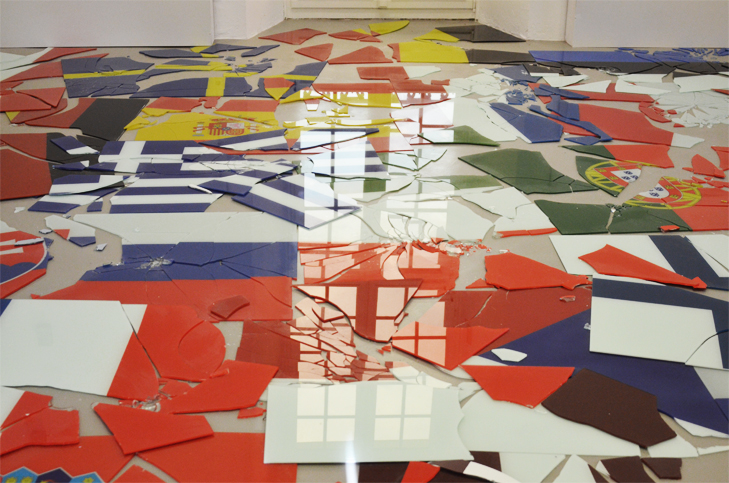
The top floor at Zwehrenturm (Fridericianum) is covered with broken glass emblems; artpiece by Costas Varotsos, part of the EMST collection (National Museum of Modern Art , Athens) shown at Fridericianum with the Antidoron project, which presents the EMST collection at documenta14 as a ‚Learning from Athens’.
Elevating the collection of the EMST (National Museum of Contemporary Art, Athens) to a central position, the Fridericianum, most central and impressive building of documenta in Kassel, is a statement that art should be shared and that there are times in which a huge effort to do so may be required. The museum was never able to open in its native Greece, and with the symbolic act of transporting the collection to Kassel, documenta steps back and honors the accomplishment of EMST as an art institution through a curatorial capacity. We hope that a lot of visitors walk the somewhat hidden and easy-to-miss side stairs of Zwehrenturm and find Nikos Tranos’ A Glacier at Our Table. Talking to the artist we learned that the soft pink refers to the pink clouds of Fukushima…
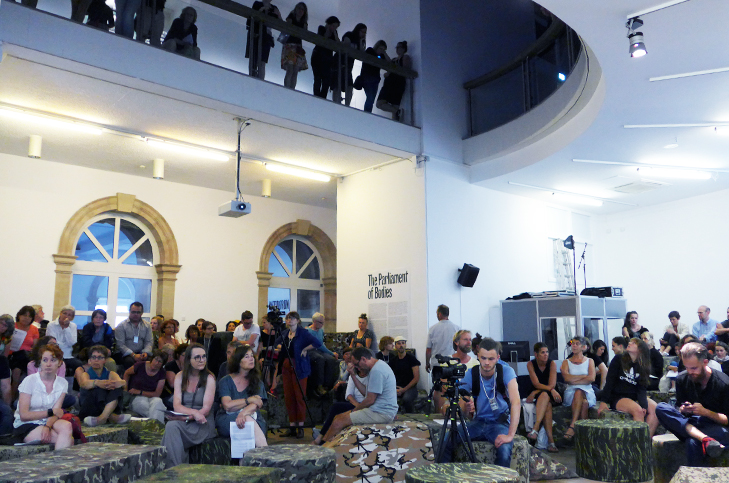
The Parliament of Bodies is part oft he public programm, curated by Paul B. Preciado for documenta14; residing at Rotunde in Fridericianum/ Kassel (photograph) and at Parko Eleftherias/ Athens. „The Parliament of Bodies proposes to act as a space for cultural activism, inventing new affects and creating synthetic alliances between different world struggles for sovereignty, recognition, and survival.“
Every five years documenta presents its concept as state of the art avantgarde, as the forethought of the Zeitgeist; and with d14 it becomes trash pressed between book covers to be shrink-wrapped into plastic (Daniel Knorr, Athens) and carried home. Rwanda strictly prohibits to enter the country carrying a plastic bag, a fact we learn about in Athens at Parko Elefterias during the Athens closing week. The Parliament of Bodies, which holds meetings in both cities, at the Parko and inside the Fridericianum Rotunde, is an elaborated open circle, run by Paul B. Preciado, talking about stuff that matters while sitting on large foam pieces: These seats are the work of Greek artist Andreas Angelidakis. Puzzled together on the last day of the Parliament of the Bodies in Athens we discover the pieces as a massive bunker, and in Kassel?! Kassel is home to a booming defense industry. We the people are invited to come together in the Parliament of the Bodies, and via Angelidakis piece we are forced to ask:
What comforts our butt? It is a panzer.
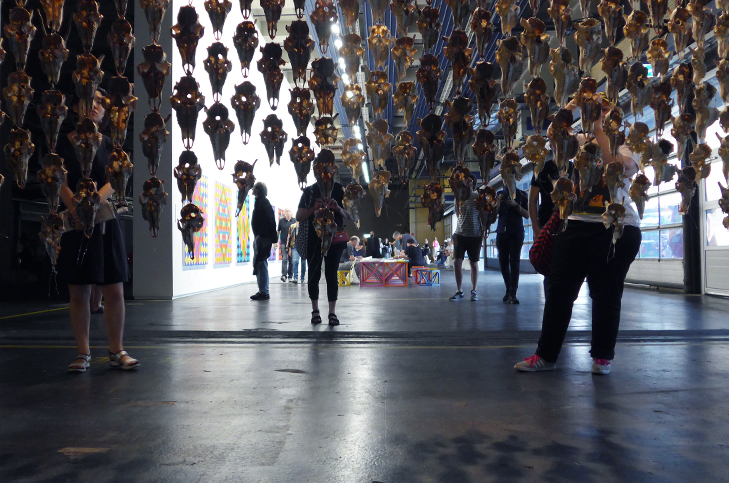
‚Pile o’ Sápmi’ is the title for Norwegian artist Máret Ánne Sara’s work: A curtain made out of reindeer skulls, all with bullet holes at the center of the skulls. The presented pieces oft he artist draw upon spiritual, ecological and political concerns. Documenta14 visitors are visibly moved, even paralysed by the piece.
d14 is operating on various levels, the world exhibition has gained and consists of a greater dimension. The artworks disappear behind the concept, but honestly, is it the time to highlight the pieces? It is the point to use art to more than ever focus on the whole with a very – perhaps most – political documenta in history. A documenta show is thought of as a seed, a stimulant that inspires, encourages, motivates, and grows into something that the future might be in need of. What flourishes from these twin seeds, time will tell.
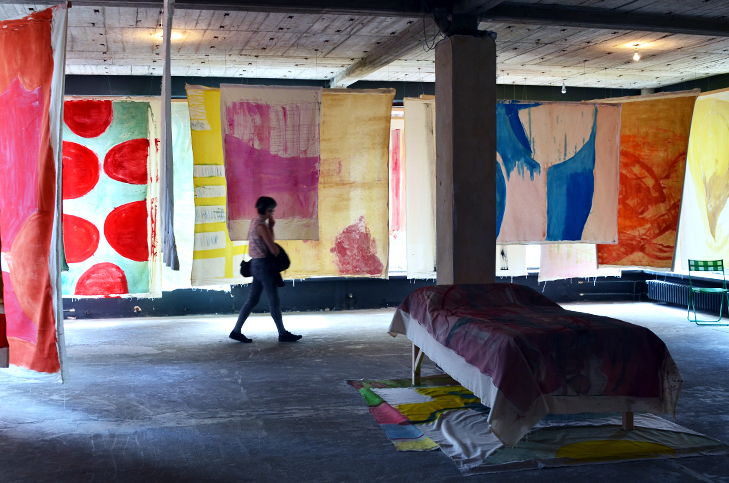
Installation of ‚Nisyros – Vivian’s Bed’.Vivian Suter’s paintings arranged in one of the documenta14 Glass Pavillions at Kurt-Schumacher-Strasse. The canvas is painted/treated with oil, pigment and fish glue, volcanics, earth, microorganisms and wood inside the crater of Stephano on the Greek island Nysiros. The exhibited bed symbolizes Suter’s bed, adding a rare flavor of intimacy.
Note by the author:
While visiting Athens, documenta felt like an adventure, people involved were truly enthusiastic and hopeful. Of course the city is also great to discover and well.. the crisis seems to make Athenians even more open – all this means Athens offered a lot more than a business as usual documenta in Kassel is able to. Being safe is scary and a little quiet.
INFO: We suggest to take the direct ICE from Berlin to Kassel (less than 3 hours) and slowly take in documenta14. And make sure to prepare or at least check out the website and get lost in good reads or recordings from Athens. (After 50/100 days Kassel counts 445.000 visitors, which is an increase of 17%.)
Author & Photo credit: Valeria Geritzen

